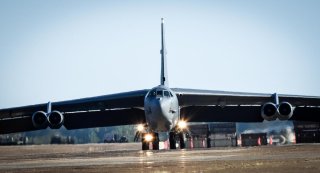Global Strike Command Is Worried About China's Growing Nuclear Stockpile
China's nuclear arsenal is growing at a fast clip.
Here's What to Remember: Ray stressed a need for the U.S. to maintain its strategic deterrence posture with a modernized nuclear triad.
China's military seems like it is growing in every direction possible.
For example, Chinese shipbuilders are adding new aircraft carriers, amphibs and destroyers at an alarming pace. Chinese armored vehicle engineers are fast-adding new infantry carriers and mobile artillery platforms. Chinese weapons developers are adding large numbers of new drones and attack robots. But the largest and potentially most alarming element of all of this, according to many senior U.S. leaders, is the staggering pace at which China is adding nuclear weapons.
“A troubling revelation has been about the trajectory of the Chinese nuclear program. The Chinese have plans to at least double their arsenal by the end of the decade. They are departing from what has been known as a minimalist theory,” Gen. Timothy Ray, Commander, Air Force Global Strike Command, told reporters at the 2021 Air Force Association Symposium.
Ray’s concern about the fast-growing Chinese nuclear arsenal aligns with and builds upon the Pentagon’s Pentagon’s 2020 China Military Report, which states that the number of warheads arming Beijing’s intercontinental ballistic missiles (ICBMs) capable of threatening America will likely grow to 200 in the next five years. As an element of this expansion, China is increasing its inventory of long-range land-fired DF-26 Anti-Ship missiles able to fire both conventional and nuclear missiles.
Ray cited a hope that China might be willing to consider joining various ongoing arms treaty discussions, but did not appear extremely optimistic about the possibility given China’s approach to nuclear weapons modernization.
“I think the need to have China in a conversation about arms control is important,” Ray says.
“Combined with a near-complete lack of transparency regarding their (China’s) strategic intent and the perceived need for a much larger, more diverse nuclear force, these developments pose a significant concern for the United States,” the 2020 Pentagon report explains.
The reality of the threat circumstance with China seemed to be one of several reasons why Ray stressed the importance of maintaining and adding to the U.S. nuclear triad, particularly in the Asian theater.
There continues to be successful U.S. and allied Bomber Task Force Patrols, including ongoing work with B-1s in India and integrated flights with nuclear-capable B-2s and B-52s. Ray said the Air Force is working vigorously to expand allied collaboration with Bomber Task Forces beyond its current scope.
“We have the highest bomber aircrew readiness in the history of the command,” he said.
Alongside an effort to emphasize the growing importance of allied operations in the Pacific, Ray stressed a need for the U.S. to maintain its strategic deterrence posture with a modernized nuclear triad.
“There are no allied bombers and no allied ICBMs. These two components are the cornerstone of the security structure of a free world,” Ray said.
What much of this contributes to, Ray explained, is the importance of continuing the current Ground-Based Strategic Deterrent program, a now underway effort to build a new arsenal of 400 U.S. ICBMs.
Kris Osborn is the defense editor for the National Interest. Osborn previously served at the Pentagon as a Highly Qualified Expert with the Office of the Assistant Secretary of the Army—Acquisition, Logistics & Technology. Osborn has also worked as an anchor and on-air military specialist at national TV networks. He has appeared as a guest military expert on Fox News, MSNBC, The Military Channel, and The History Channel. He also has a Masters Degree in Comparative Literature from Columbia University.
This article is being republished due to reader interest.
Image: Flickr

